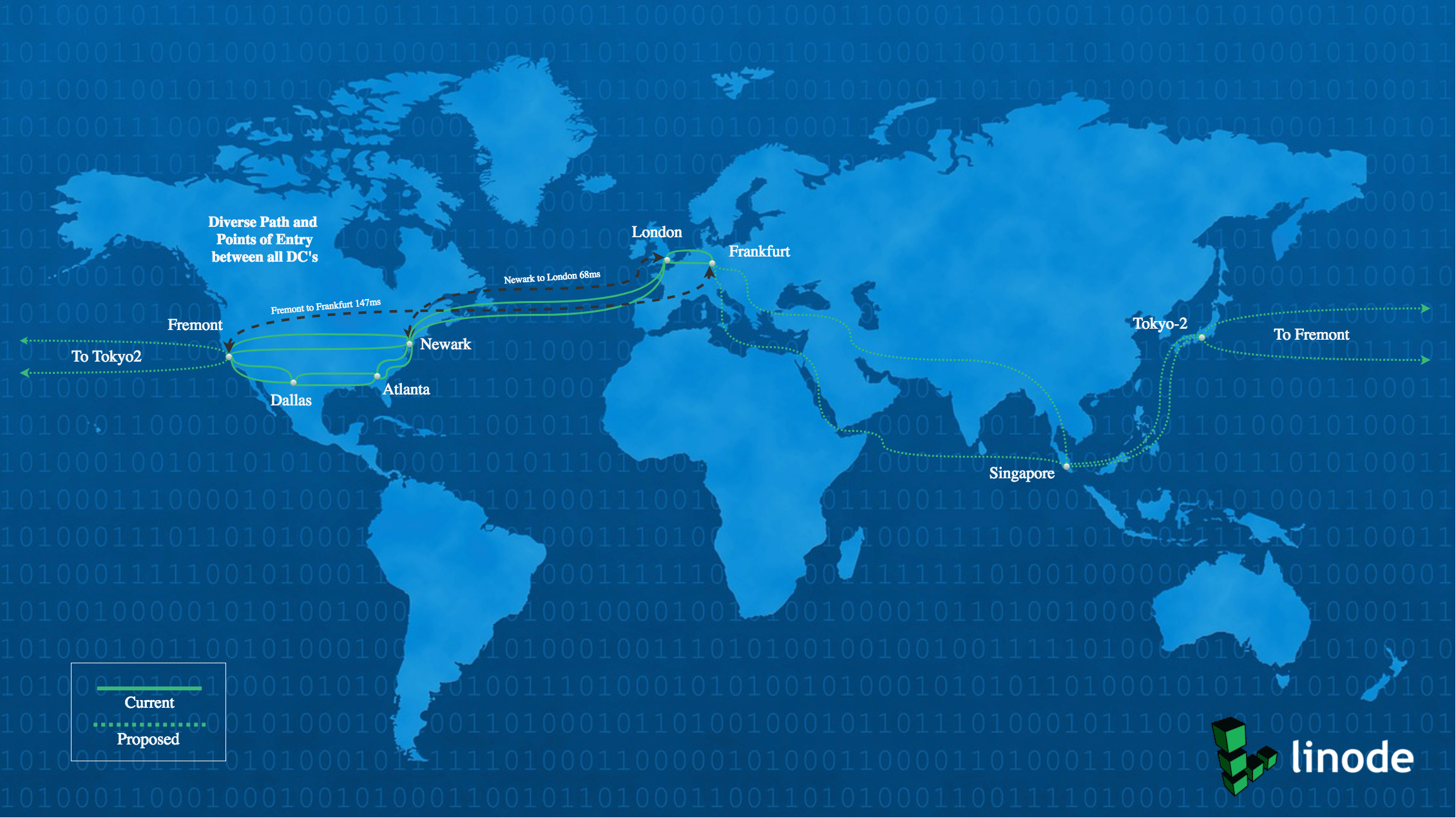Tal y como explicamos en nuestra última actualización de la red, nuestro departamento de ingeniería de redes ha trabajado duro para renovar toda nuestra red de cara a Internet, aumentando la capacidad y estableciendo acuerdos directos con cientos de redes de todo el mundo. Desde entonces, hemos ampliado nuestra red troncal a todos los centros de datos de Norteamérica y Europa. Esto significa que cualquier comunicación entre los centros de datos de Linode nunca saldrá de nuestro ASN 63949. Tener una conectividad privada directa entre nuestros centros elimina la volatilidad de Internet.
Los clientes pueden confiar en que sus aplicaciones multisitio alojadas con nosotros podrán comunicarse a través de los medios más rápidos y fiables posibles. Nuestros ingenieros han trabajado estrechamente con nuestros proveedores para elegir las rutas de fibra más cortas posibles, lo que a su vez proporciona a nuestros clientes la menor latencia entre ubicaciones. En nuestra ruta actual más larga (Fremont DC a Frankfurt DC), hemos podido reducir el RTT en más de 15 ms. También hemos visto desaparecer los inevitables episodios de inestabilidad y pérdida de paquetes relacionados con Internet.
Aunque ofrecer una conectividad directa entre las interfaces públicas de Linodees estupendo, no pensamos detenernos ahí. Nuestros ingenieros han invertido innumerables horas en establecer relaciones y forjar acuerdos con cientos de redes de contenidos y de globos oculares. Ahora, con una red troncal acelerada y fortificada, podemos extender los beneficios de estas relaciones que actualmente están contenidas en un solo centro de datos a cualquier centro de datos a lo largo de nuestra red troncal. Por ejemplo, los clientes de Newark se beneficiarán directamente de nuestras sólidas relaciones de peering en Europa y viceversa. Cuanto menos tráfico se envíe a través de múltiples saltos de tránsito, mejor será la nube que ofrecemos a nuestros clientes.
Ahora que los centros de distribución norteamericanos y europeos de Linodeestán integrados, hemos empezado a ocuparnos de nuestra red AsiaPAC. Durante un reciente viaje a Singapur, nuestros ingenieros de red iluminaron con fibra oscura uno de los edificios con mayor densidad de portadores de Asia, lo que nos da la base para ampliar nuestra red troncal también allí.









Comentarios (29)
To improve Asian network performance, Linode can consider lighting up dark fibres to Hong Kong solely as a network PoP. That way you can cover more Asian countries like the Philippines, Brunei, Taiwan, Cambodia and Vietnam and provide redundant routes for these countries as their links to Singapore or Tokyo are not as stable as the ones going to Hong Kong.
Good Job!!! Linode always Rocks…
Goooood job guys! So, there will be a global private network with a unique private IP range shared between Datacenters?
@Diego Thanks! It might be something we can consider, we’re always looking to make our service even better.
Excellent news 🙂 I’m in AsiaPAC exclusively at the moment, so I look forward to the work done there 🙂
Come to StrayaaAAA!
awesome Linode Rocks
Yeah yeah thanks Linode!!!
Any plans to increase egress, i.e. currently 1Gbs out?
Awesome job. Speed is important if one makes app syncing between two data centres
Great News!
We’ll love to have backup service across 2 datacenters ! (and private networks 🙂 )
E.
Next POP should be in Australia! Tons of business here!
+Stephen Reese
If you have a low cost Linode, than 1Gbps is a good amount of bandwidth for most usage scenarios. You could always set up a cluster of cheap Linodes over multiple datacenters in order to increase your aggregate bandwidth.
Does Linode with these network upgrades plan on increasing usage quotas on Linodes?
I’m getting 174ms latency between Fremont and Frankfurt. Your diagram says that should be 147ms.
What gives with that?
@John Our North American ring consists of diverse paths between each DC. The primary path between Fremont and Newark was down due to a fiber cut which caused traffic to take the longer secondary path. It just so happens that we were working with our provider to get the secondary path shorter which happened in the last 48 hours. RTT for both paths should be around 146ms now. Please let us know if you see otherwise!
Wow you guys are serious! Is transfer between DC’s “free” do you know? Just out of curiosity 🙂
Great news for those in Asia! Any good news in a short future for us here in South America? I have linode for almost 3 years and the pricing with quality is unbeatable but unfortunatelly it’s not a fast connection.
Nothing in the immediate future, but we’re always considering new ways to help our customers – we won’t rule it out!
Great Linode Rocks
Glad to see Linode working hard! 🙂
Nice job, Linode always stays at the top
Hello,
do you have a high level schematics of your datacenter network layout ?
regards
Though we do not provide the network schematics from our end, our peering partners and some other information regarding our network are listed on Hurricane Electric’s site:
https://bgp.he.net/AS63949
Awesome, this is great news. Linode always provides great value and I can see it’s only getting better.
Hmm…interestingly, for fun, I did a speed test from a linode, downloading a file from vultr (san jose silicon valley) and from linode (silicon valley fremont). It downloaded much faster from vultr? hmm…am I an outlier?
are you going to post news about linode network backbone?
How can we establish Bilateral Peering Request over DE-CIX Infrastructure with lonide?
Linode* Sorry for spelling mistake.
Hey Kushal – if you’re interested in peering with Linode, you can reach out to our team at peering@linode.com.